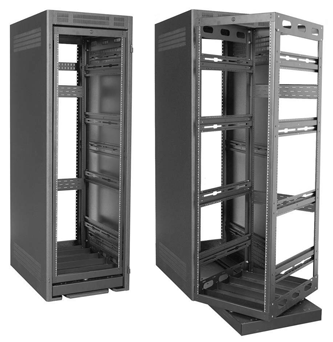Enhancing The Value Proposition Of Equipment Racks
All racks are created equal. Or are they?
Sure, equipment racks are usually black. They are created for the same purpose: to store AV devices safely and with signal fidelity. They are usually made of metal. So, what’s the magic? Why should you buy one rack versus another? And in 2010, which features will help installers build more margins into their projects?
Lowell LHR-series
To understand margins, there has to be an understanding of what “value” really means in a project, said Lowell Manufacturing national sales manager, Jeff Garstick.
Upselling and adding rack features like power management and rack cooling can solve technological concerns, but in the value equation, one must consider efficiencies from every aspect.
“Racks are usually relegated to a corner closet,” he said, “but their intrinsic value comes at the integration stage, so while the function may seem invisible, the value of the purchase is that the system works.”
Labor is the largest expense involved in any project, Garstick said. Business owners try to figure out how to get more projects done more efficiently and achieve more productivity yield per staff member. “So, in the shop and field, integrators must be able to transition in an application, because many times, conditions can change on you,” he added.
Another significant margin builder, Garstick said, is “the ability to show electrical contractors you can save cost and bid more” by showing in the blueprints and schematics how and where power will flow.
Corporate America, education, and digital signage are strong areas of growth for equipment rack sales, he said. He believes as the market irregularities ride out in 2010, business will return to more markets in the commercial AV space.
But no matter which sectors you’re working in, features that make the job quicker and easier are not just appreciated, they are expected. For this reason, many Lowell racks can be cut in the field. “This saves so much time for installers who would usually have to take it back to the shop,” Garstick said.
Atlas Sound’s Steve Young agreed that in the field, ease of installation equals value. And value equals margins. “We are always interested in the best use of space, space is a premium,” he said.
Also critical is the value offered to contractors by way of freight programs. Atlas Sound continues to add depth to their product lines, and the addition of a new line of power distribution and management products helps make them a “one stop shop.” Young said this helps increase margins through a better program and freight, as well as the technology advantages of more system protection and monitoring capabilities.
Models with the Atlas Sound monitoring feature are ECS-6RM, ECS-3, and AP-C15D. The ECS- 6RM is also the sequencer head unit for use with the modular raceway system. The control models are the ECM-20SH, ECM-15SH, ECM- 20M, ECM-20.
New accessories from Atlas Sound, like the MMK17 and ASUMRM9, also meet the growing demands of integrators. These parts are designed for software controlled systems and keyboard/monitors right at the racks for more ease of use. Since custom work is another margin builder, Atlas Sound offers Assemble To Order (ATO) service.
When it comes to protecting margins, are contractors saving dimes, but costing themselves or their clients hundreds of dollars in the long run? Ask Mark Tracy, director of product management and business development, Middle Atlantic Products.
Tracy believes that best practices create success, whether it is a budget issue or performance issue. “Best practices build margins,” he believes, and when you do the right thing for the end user, you win. “Pay attention to the total systems approach, you will get paid for it, and it will certainly win you jobs in the future.”
Middle Atlantic offers a diverse array of products, but all their lines share common goals: to help ensure reliable systems, to make the best use of the space allotted, and to save the installer time and money. Middle Atlantic’s cable management method is proof of that. It utilizes a variety of lacer bars to allow installers to route cables from the sides of the rack to the connection at the rear of equipment, for example. Managing cables in this way allows better upward airflow in the rear of the rack that could otherwise be obstructed by large cable bundles hanging down from the rear of equipment, and allows easy access to connections for servicing.
This underscores Tracy’s maxim that key rack considerations (cable, thermal, power management) can positively affect one another. “Proper cable management helps cooling by helping airflow, intelligent cooling helps power by saving energy, power management helps keep the system quiet by ensuring signal integrity,” Tracy said.
He also recommended that contractors integrate the rack in the shop, and in case they don’t, Middle Atlantic has a variety of products that can ship quickly, help save time, and finish the job. Middle Atlantic created its IsoCenter Rackmount Isolation Transformer System to address power and grounding issues, underscoring how best practices help build margin.
Middle Atlantic thinks that the healthcare and education markets will continue to grow in 2010, and that entertainment in hospitals is a particularly bright spot on the horizon. “People heal faster when they’re in a stronger frame of mind,” he added. The ELF Foundation “Rooms of Magic” (home theaters in children’s hospitals) and in-room video are testaments to that idea.
